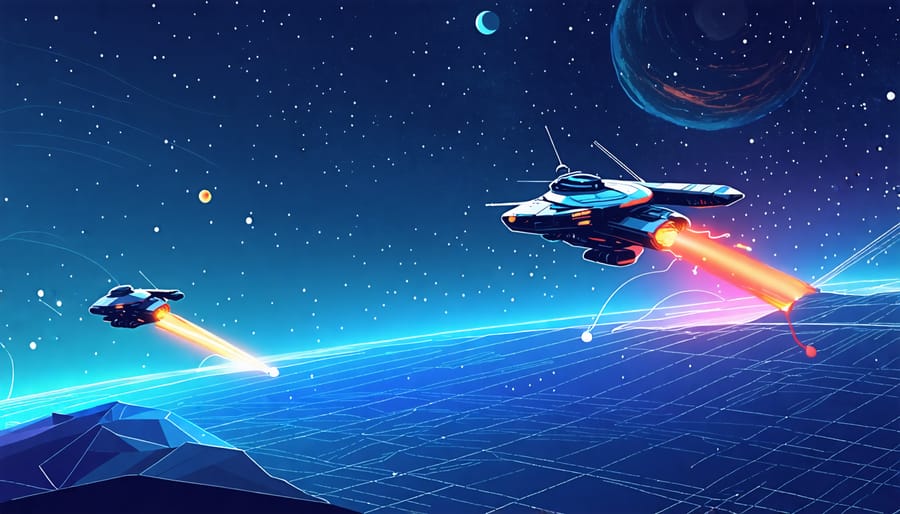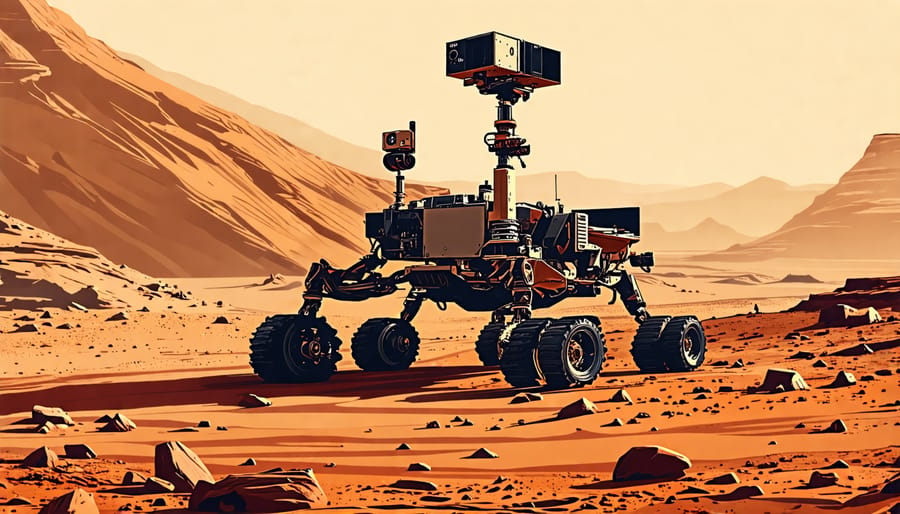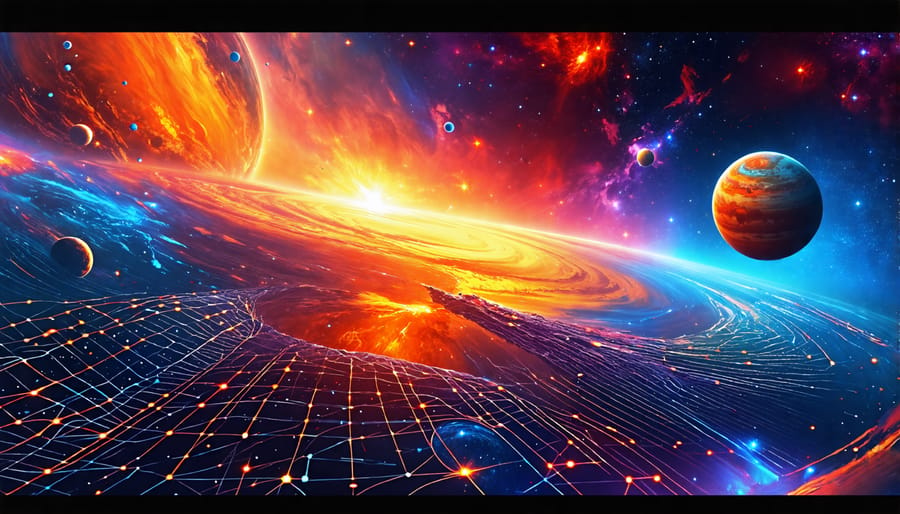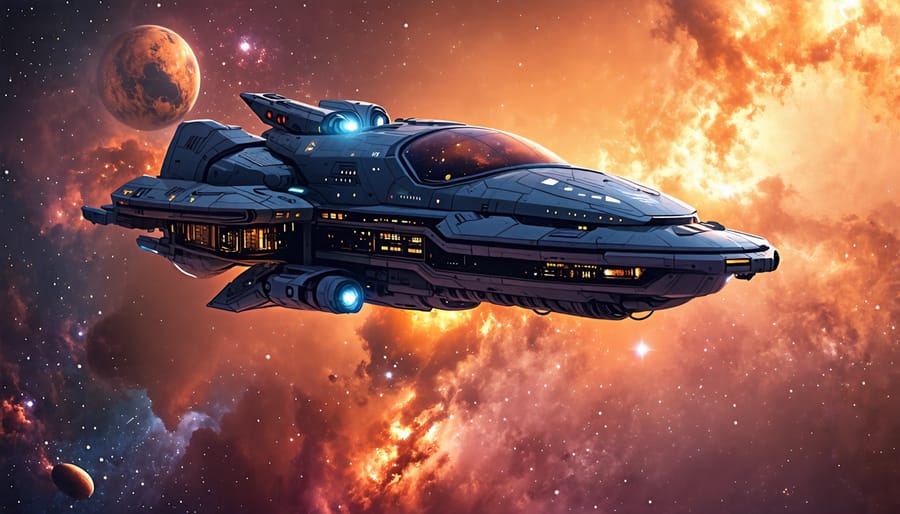As artificial intelligence boldly ventures into the final frontier, it is revolutionizing space exploration and unlocking cosmic mysteries. AI’s sophisticated algorithms are empowering spacecraft to navigate autonomously through the vastness of space, making split-second decisions and adapting to unpredictable conditions. With AI’s growing role, robotic probes are becoming more intelligent and capable, able to analyze alien worlds, collect samples, and make groundbreaking discoveries with unprecedented efficiency. Furthermore, AI is accelerating the search for habitable exoplanets and extraterrestrial life by sifting through immense amounts of telescope data, detecting subtle patterns that human eyes might miss. As we stand on the brink of a new era in space exploration, artificial intelligence is not merely a tool—it is an indispensable partner in humanity’s quest to unravel the secrets of the universe and extend our reach to the stars.
AI-Powered Spacecraft Navigation

Machine Learning Models
Machine learning models are revolutionizing autonomous space navigation, enabling spacecraft to make intelligent decisions without human intervention. One of the most promising approaches is deep reinforcement learning, which allows spacecraft to learn optimal navigation strategies through trial and error in simulated environments. This technique has been successfully applied to asteroid navigation, where models are trained to guide spacecraft through complex asteroid fields while avoiding collisions.
Another key application is computer vision, with convolutional neural networks being used to analyze images and identify safe landing sites on distant planets and moons. These models can detect hazards like boulders and craters in real-time, ensuring a smooth touchdown. Recurrent neural networks are also being explored for trajectory optimization, leveraging their ability to process sequential data to predict the most efficient paths through space.
As Dr. Elena Adams, a space navigation expert, notes, “Machine learning is opening up new frontiers in autonomous space exploration, allowing us to venture further into the cosmos than ever before.” With continued advancements in these models, the possibilities for intelligent space navigation are truly out of this world.
Real-World Applications
Artificial intelligence is revolutionizing space exploration, enabling autonomous navigation and decision-making in missions like NASA’s OSIRIS-REx and the Mars 2020 Rover. OSIRIS-REx, launched in 2016, utilized AI algorithms to analyze images and data to identify the best location for collecting a sample from the asteroid Bennu. The spacecraft successfully navigated around the asteroid’s surface and obtained a pristine sample, set to return to Earth in 2023. Similarly, the Mars 2020 Rover, Perseverance, leverages AI for autonomous driving, allowing it to traverse the Martian terrain more efficiently. Its AI-powered system processes images from multiple cameras to create 3D maps, detect obstacles, and determine the safest path forward. These advancements in AI are crucial for future missions, particularly in the outer solar system where communication delays make real-time control from Earth impractical. As AI continues to evolve, it will undoubtedly play a pivotal role in unlocking new frontiers in space exploration.
Intelligent Robotic Explorers

Computer Vision Breakthroughs
Recent breakthroughs in computer vision are revolutionizing the way space probes explore our solar system and beyond. Advanced algorithms and deep learning techniques enable probes to autonomously analyze terrain, identify features of interest, and make real-time decisions. For instance, NASA’s Perseverance rover on Mars utilizes state-of-the-art computer vision to navigate the rugged Martian landscape, detect obstacles, and select optimal paths for exploration. It can also identify and collect promising rock samples for further analysis, all without human intervention.
Moreover, computer vision allows probes to create detailed 3D maps of planetary surfaces by stitching together images from multiple angles. This technology has been instrumental in mapping the intricate canyons and valleys on Mars, as well as the icy moons of Jupiter and Saturn. As Dr. Emily Lakdawalla, a planetary geologist at The Planetary Society, explains, “Computer vision is like giving these probes a pair of eyes and a brain. They can now perceive and understand their surroundings in ways that were once impossible.”
Looking ahead, even more sophisticated computer vision systems are in development, promising to unlock new frontiers in space exploration. From detecting signs of past or present life to identifying resources for future human missions, the possibilities are endless.
Adaptive Control Systems
Adaptive control systems are a crucial component of AI in space, enabling rovers and other robotic explorers to adapt to the unpredictable and harsh conditions they encounter on distant planets and moons. These intelligent systems leverage machine learning algorithms and sensor data to make real-time decisions, allowing the rovers to navigate autonomously, avoid obstacles, and optimize their movements for maximum efficiency.
One notable example is NASA’s Curiosity rover, which employs an adaptive control system called AutoNav. This system analyzes images from the rover’s cameras to create 3D maps of the surrounding terrain, identifying safe paths and potential hazards. By continuously updating its understanding of the environment, AutoNav enables Curiosity to traverse the rugged Martian landscape with minimal human intervention, making decisions based on the changing conditions it encounters.
As NASA’s Jet Propulsion Laboratory robotics technologist Masahiro Ono explains, “AutoNav’s enhanced navigation capabilities will enable Curiosity to cover more terrain and make more discoveries.” This adaptive approach not only increases the rover’s autonomy but also maximizes the scientific value of each mission by allowing it to explore more territory and gather more data.
Looking ahead, the development of even more sophisticated adaptive control systems will be essential for future robotic missions to the outer reaches of our solar system and beyond, where communication delays make real-time control from Earth impractical. By empowering rovers and other space robots with the ability to think and adapt on their own, AI is paving the way for a new era of space exploration and discovery.
Discovering New Worlds with AI
The search for habitable worlds beyond our solar system has long captivated the human imagination. With the advent of artificial intelligence (AI) and machine learning, this quest has taken a giant leap forward. Scientists are now harnessing the power of AI to detect and analyze exoplanets—planets orbiting stars other than our Sun—with unprecedented efficiency and accuracy.
Machine learning algorithms excel at recognizing patterns in vast amounts of data, making them invaluable tools for sifting through the cosmic haystack of astronomical observations. By training these algorithms on known exoplanet data, researchers can teach them to identify the subtle signatures of distant worlds in the light of their host stars.
One groundbreaking example is the use of deep learning neural networks to detect exoplanets in data from NASA’s Kepler space telescope. As explained by astrophysicist Dr. Jessie Dotson, “These algorithms can pick out the faint dimming of a star caused by an orbiting planet, even when that signal is buried in noise.” This AI-powered approach has already led to the discovery of hundreds of previously overlooked exoplanets.
But detecting exoplanets is only half the battle. To determine whether a world might be habitable, researchers must analyze factors like its size, orbit, and the properties of its host star. AI is revolutionizing this process as well, enabling scientists to rapidly assess the potential habitability of newly discovered exoplanets and prioritize the most promising candidates for further study.
As we stand on the brink of a new era in exoplanet exploration, AI is poised to play an increasingly crucial role. With upcoming missions like NASA’s James Webb Space Telescope set to provide an unprecedented view of the cosmos, machine learning will be essential for making sense of the deluge of data and bringing us closer to answering one of humanity’s most profound questions: Are we alone in the universe?

The Future of AI in Space
Pushing the Boundaries
The potential of AI in space exploration is truly astronomical. By leveraging advanced machine learning algorithms, future missions could venture into uncharted territories and unravel cosmic mysteries that were once deemed impossible. Autonomous navigation systems powered by AI could enable spacecraft to make real-time decisions, adapting to dynamic conditions and enabling missions to remote destinations without constant human intervention. As Dr. Lisa Kaltenegger, Associate Professor of Astronomy at Cornell University, explains, “AI could revolutionize how we search for habitable worlds and signs of extraterrestrial life by processing vast amounts of data from telescopes and identifying subtle patterns that humans might miss.” With AI as our cosmic compass, the boundaries of space exploration are being pushed to new frontiers, promising groundbreaking discoveries that could reshape our understanding of the universe and our place within it.
Ethical Considerations
As AI systems become more integrated into space missions, from autonomous navigation to scientific data analysis, it is crucial to develop and deploy them responsibly. This means ensuring AI is robust, reliable, and aligned with human values. Researchers must prioritize safety, fairness, and transparency to prevent unintended consequences and maintain public trust.
Collaboration between AI experts and space agencies is essential for establishing best practices and ethical guidelines. This includes rigorous testing, fail-safe mechanisms, and ongoing monitoring of AI performance. Responsible AI development in space also requires addressing issues of data privacy, bias mitigation, and accountability. As we push the boundaries of exploration with AI, maintaining a strong ethical foundation will be key to realizing its immense potential for good while navigating the challenges ahead. By proactively incorporating ethics into the design and deployment of space AI systems, we can ensure this transformative technology benefits humanity in our cosmic quest for knowledge.
Conclusion
The symbiosis between artificial intelligence and space exploration is an exhilarating frontier, brimming with transformative potential. As AI systems continue to evolve and adapt to the challenges of the cosmos, they are unlocking new possibilities for scientific breakthroughs and exciting discoveries. From autonomous spacecraft navigating the vast expanses of our solar system to intelligent algorithms sifting through the cosmic haystack in search of habitable worlds, AI is revolutionizing our understanding of the universe.
As we stand on the precipice of a new era in space exploration, it is clear that the marriage of AI and space technology will be the catalyst for unraveling the mysteries that have captivated humanity for millennia. The future is bright, and the stars are within our reach. With AI as our intrepid guide, we are poised to embark on a journey of cosmic discovery that will redefine our place in the universe.

